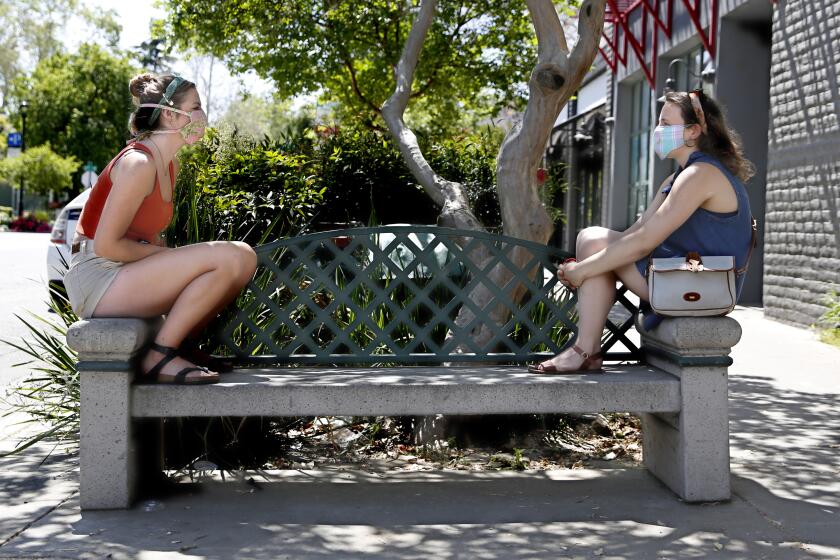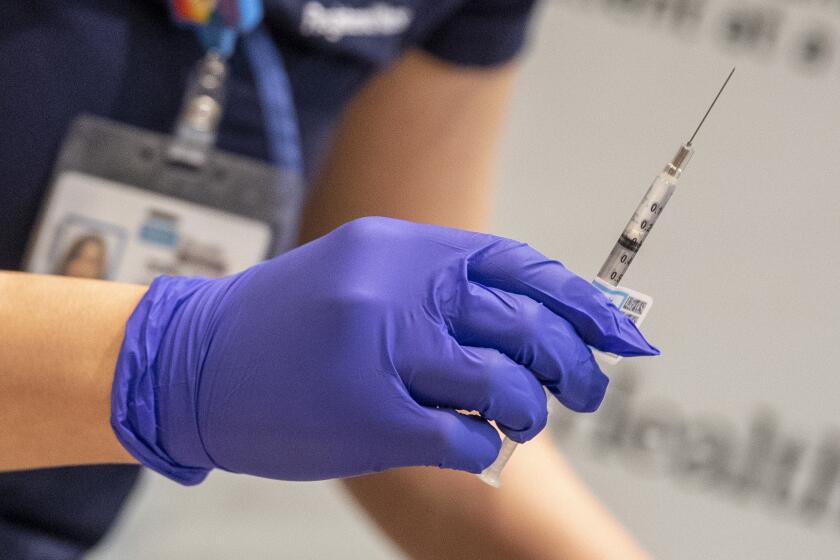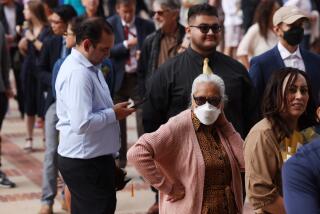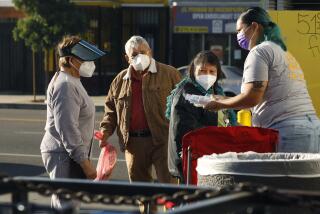While L.A.‚Äôs coronavirus numbers improve, county reaches ‚Äėterrible milestone‚Äô
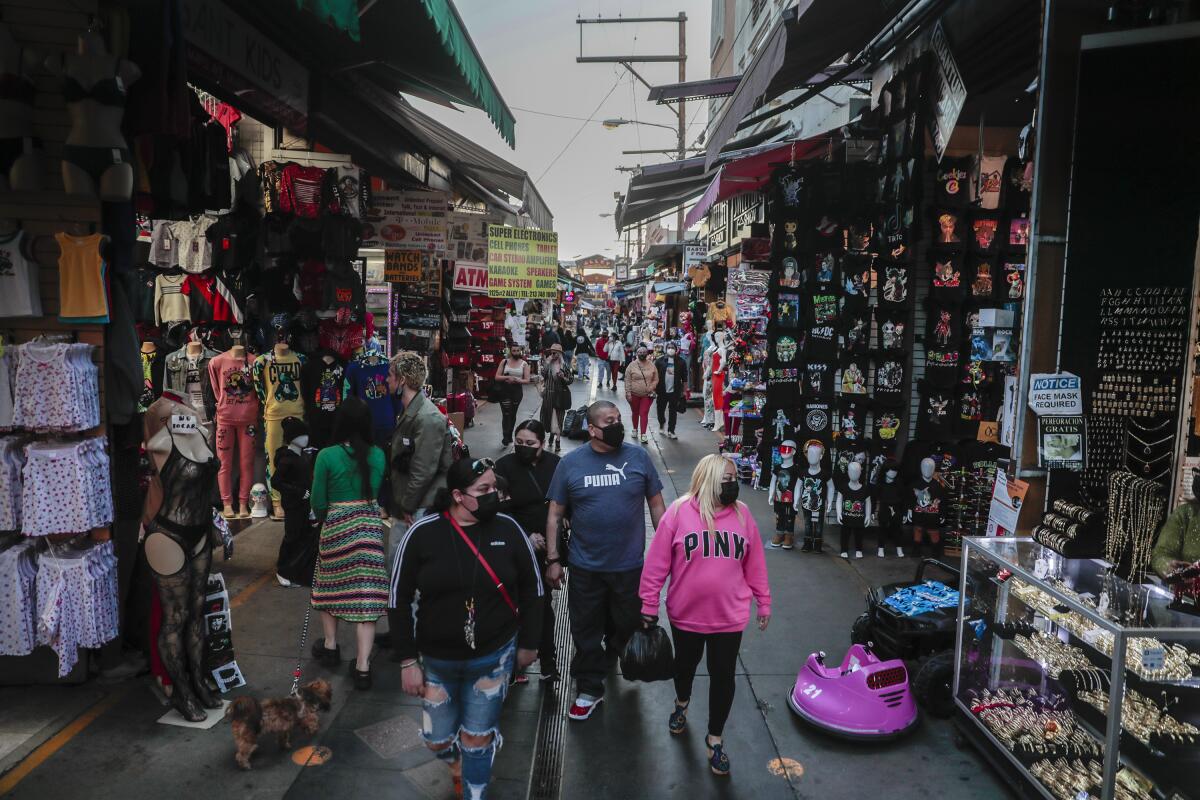
Los Angeles County has surpassed 20,000 deaths from COVID-19, the public health department announced Tuesday, even as daily coronavirus case counts are tumbling.
An additional 157 deaths were reported Tuesday, bringing the death toll to 20,057. The United States passed 500,000 deaths Monday.
‚ÄúToday, we‚Äôve approached the terrible milestone of 20,000 deaths,‚ÄĚ L.A. County Public Health Director Barbara Ferrer said Tuesday during a Board of Supervisors meeting. ‚ÄúThis is a reminder to all of us that there are collective actions that we must continue to make. They make a difference, and they save lives.‚ÄĚ
The county also reported 2,091 new coronavirus cases, bringing the total since the start of the pandemic to 1,183,378.
Despite what Ferrer called a ‚Äúheartbreaking day,‚ÄĚ she was cautiously optimistic about improving COVID-19 numbers.
At a news briefing Monday, Ferrer said daily coronavirus case counts in Los Angeles County are reaching lows not seen since before the winter surge. L.A. County recorded an average of 1,900 coronavirus cases a day for the week through Monday, down 88% from early January, when there were more than 15,000 new cases a day.
‚ÄúWe continue to make progress in reducing the average daily number of new cases of COVID-19,‚ÄĚ Ferrer said.
L.A. County is also seeing a decline in deaths. In early January, the county recorded an average of 241 COVID-19 deaths a day over a seven-day period; for the most recent seven-day period, the county saw an average of 116 deaths a day, a decline of 52%.
Additionally, the county’s rate of positive test results, which exceeded 20% around Jan. 1, has fallen below 5%, Ferrer said.
The effective transmission rate in L.A. County has dropped from 0.81 a week ago to 0.76, meaning that for every 100 infected people, the virus is being transmitted to 76 people.
Numbers are also improving at the statewide level. California’s rate of positive test results, which peaked Jan. 7 at 14.3%, has fallen to 3.1%, a figure not seen since Nov. 1, according to a Times analysis. The state is recording about 7,000 new coronavirus cases a day, down from 45,000 a day just six weeks ago.
Several counties could be eligible to resume indoor operations, but don’t expect changes in L.A. County anytime soon.
Calling the numbers ‚Äúvery good news,‚ÄĚ L.A. County Health Services Director Dr. Christina Ghaly said hospitalization rates are also steadily declining.
As of Sunday, there were 2,146 patients admitted to county hospitals with a confirmed case of COVID-19, a 73% drop from the peak of 8,098 on Jan. 5. Of those, 660 were in an intensive care unit, a 62% drop compared with the peak of 1,731 on Jan. 8.
Still, county officials warn that hospitals remain busy.
The number of people in the hospital in L.A. County with COVID-19 is about the same as it was around Thanksgiving, after the latest surge began.
The county’s publicly run hospitals were at 72% occupancy Monday, county officials said in an email to The Times on Tuesday. Publicly run hospitals have about 150 COVID-19 patients, 40% of whom are in the ICU.
‚ÄúWe are still seeing a large number of patients with very long ICU stays,‚ÄĚ Ghaly told the Board of Supervisors on Tuesday.
The effects of the surge are still being felt throughout the county’s public healthcare system.
Out of five outpatient clinics that closed during the surge to free up staff to help hospitals, only one has reopened. And although hundreds of nurses who had been on loan to hospitals during the surge have moved back to their normal jobs, some are still working at the hospitals. All U.S. Department of Defense staff members who had been assisting the county-run hospitals have departed.
The county is actively rescheduling non-urgent surgeries and procedures that were postponed during the surge.
Both Ghaly and Ferrer hedged their optimism, noting that this week could bring increases in cases resulting from gatherings over Super Bowl weekend.
‚ÄúAn increase in the behaviors that facilitate transmission can still very easily lead to an uptick in the number of hospitalized patients in just a couple of weeks,‚ÄĚ Ghaly said. ‚ÄúThis can happen very quickly, and as we all know, it‚Äôs very difficult to then turn things around and start to force those numbers back down.‚ÄĚ
Contributing to the improving numbers is the ongoing rollout of the COVID-19 vaccine. As of Monday, nearly 1,771,000 doses had been administered across L.A. County, according to the Public Health Department. Of those vaccinated, just over 513,500 have received a second dose.
Currently, only healthcare workers, residents and staff of nursing and long-term care facilities and residents 65 and older are eligible for the vaccine in L.A. County. Yet even as supply issues plague statewide inoculation efforts, three additional sectors will become eligible to receive vaccines March 1: education and child-care workers, food and agriculture workers and law enforcement personnel and other emergency responders. Together, they make up about 1.3 million people in the county.
The eligibility pool will deepen further March 15, when Californians ages 16 to 64 who are disabled or at high risk for morbidity and mortality from COVID-19 will be able to receive vaccinations.
More than 90% of the vaccines L.A. County receives are ‚Äúin the arms of people who are eligible‚ÄĚ within five days, Ferrer said, but fluctuating supply levels are creating challenges. Though there were 500,000 available appointments this week, the county had only 209,000 doses.
‚ÄúAcross all sectors, there‚Äôs much more capacity to vaccinate,‚ÄĚ Ferrer said, ‚Äúbut we simply do not have the supply of vaccine to offer more appointments.‚ÄĚ
As has been the case throughout the vaccine rollout, wherever there is a slight opening, the resourced and tech savvy find their way in.
Meanwhile, public health data released last week revealed that vaccination rates among Black and Latino residents were lagging far behind those of white residents. Although 32.7% of the state’s white residents have received at least one dose of vaccine, only 3% of the state’s Black residents and 16% of Latino residents have received one.
Ferrer addressed the inequities and apologized to the communities that have had limited access to vaccines.
‚ÄúWe have and do extend our apologies,‚ÄĚ she said. ‚ÄúIt‚Äôs not about talk at this point, though. It‚Äôs really about shifting the ability of us to make sure that we‚Äôre improving access in those communities.‚ÄĚ
Both county and state public health officials have reaffirmed their plans to address inequity issues and reach people in hard-hit areas through community outreach and mobile vaccination efforts, but some feel it isn’t enough.
During the L.A. County Board of Supervisors meeting Tuesday, Supervisor Hilda Solis said she was disgusted by the behavior of residents, largely from affluent neighborhoods, who used access codes that were supposed to go to Black and Latino residents to register for vaccination.
Solis said she was shocked to see residents from affluent neighborhoods coming to a clinic hosted at a public housing site in Boyle Heights, where local residents, many of whom ‚Äúlive in poverty‚ÄĚ and are largely Latino, Black and Asian, were supposed to be getting vaccinated.
‚ÄúPeople don‚Äôt usually go in and visit from outside communities like Beverly Hills or the Westside or other parts of the county, but on this occasion, I happened to see people that I know don‚Äôt live and reside there,‚ÄĚ she said.
Solis said the state’s My Turn program is failing to provide access to vaccine to communities of color, and she’s hearing from residents whose calls are dropped when they call the My Turn phone number.
Solis called Tuesday a ‚Äúday of reckoning‚ÄĚ and said abuse of the code system was a bad mark on the state and county.
‚ÄúFolks, this is much more than jumping the line,‚ÄĚ Solis said. ‚ÄúThis means that our community is being pushed out.‚ÄĚ
During the same meeting, Ghaly said she was concerned about the barriers the 450,000 patients who seek care at the county’s hospitals and clinics are facing to get vaccinated. Many are people of color, low income and on public insurance, including Medicaid, or are uninsured. Ghaly said her agency needs better access to reserve vaccination appointments.
‚ÄúIf we aren‚Äôt able to reserve vaccination appointments for our patients, we are very concerned that they‚Äôll be pushed out by those with more free time, more resources, the ability to sit in front of their computer all day and the ability to drive anywhere in the county for a vaccine,‚ÄĚ Ghaly said.
She said the strategies officials have discussed for addressing inequities, including the access codes, ‚Äúare just not acceptable or sufficient solutions.‚ÄĚ
‚ÄúThose systems can be easily gamed by people with better access,‚ÄĚ she said.
Supervisor Janice Hahn said that in order to ensure equity, the county might need to go door to door to provide vaccines or, once the Johnson & Johnson single-dose vaccine is available, target community gathering sites, such as houses of worship, and provide everyone there with a shot.
‚ÄúWhen we say targeted, we mean either door to door or in the community at a particular location so we can maybe mitigate folks from outside taking those vaccines,‚ÄĚ Hahn said.
Even as officials work to address equity issues within the vaccine rollout, they are bracing for the rise of more transmissible variants of the virus, including a California strain that looks increasingly dangerous.
More to Read
Sign up for Essential California
The most important California stories and recommendations in your inbox every morning.
You may occasionally receive promotional content from the Los Angeles Times.
